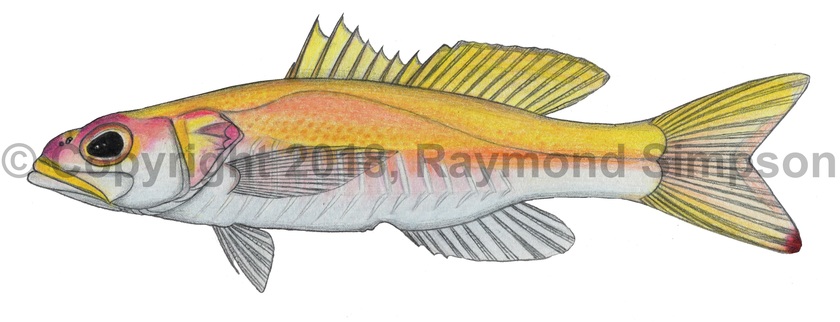
Common Name
Spot-tail Golden Bass
Year Described
Baldwin & Robertson, 2014
Identification
Dorsal Fin: VIII, 13
Anal Fin: III, 8.5
Pectoral Fin: 15
Pelvic Fin: I, 5
Gill Rakers: 20-21 (first arch)
Lateral Line Scales: 47-48
Vertebrae: 24 (10 precaudal, 14 caudal)
Body elongate, compressed, and robust. Body depth 23-26% SL. Head bluntly pointed but snout more squared off than relatives in the genus. Forehead profile slightly convex. Eye large (9.4-12% SL). Mouth extends to rear half of orbit. Lower jaw projects. Rear corner of maxilla with a blunt ventral projection. Preopercle not serrated. Opercle with one stout middle spine and two accessory spines. Spiny and soft dorsal fin connected by fin membranes, but with a strong notch. Dorsal, anal and caudal fin with bluntly rounded tips. Caudal peduncle strong. Tail slightly forked with bluntly pointed lobes. Body and entire head with small ctenoid, deciduous scales. Fin membranes scaled.
Color
Body rosy red with a broad yellow wash over the dorsal half of the body (more extensive in juveniles). Larger fish have yellow more reduced to marbling or irregular mottling on dorsum. Head and nape usually brighter rose to red extending back under the dorsal fin. No bands through eye or on head. No spots on body. Ventral half of trunk with 10+ distinctive pearly white chevrons that contrast with body color. Belly white. Dorsal fins mostly translucent yellow with a little pink on the rear soft dorsal. Caudal fin pink with yellow upper and lower lobes. Tip of lower caudal lobe brown to brick red. Anal and pelvic fins translucent white to pink. Eye reddish.
Size
Maximum size to 143mm SL.
Habitat
Mesophotic on deep reefs, rock outcrops and walls (182-275m).
Range
Scattered records from the Caribbean Sea (Bahamas, Honduras, Curacao).
References
Baldwin, C. C., & Robertson, D. R. 2014. A new Liopropoma sea bass (Serranidae, Epinephelinae, Liopropomini) from deep reefs off Curaçao, southern Caribbean, with comments on depth distributions of western Atlantic liopropomins. ZooKeys, (409), 71.
Other Notes
The genus Chorististium had been erected in the past for these smaller Liopropoma with more separated dorsal fins (rubre, carmabi, mowbrayi, eukrines in our area). The genus Pikea was used for larger Liopropoma with notched but noticeably connected dorsal fins (aberrans, olneyi, santi in our area). Recent phylogenetic work shows Liopropoma is paraphyletic with the inclusion of Bathyanthias in the phylogeny, so they will eventually all be lumped into Liopropoma or several new genera will be proposed for the different clades.
Liopropoma santi has a noticeably different head and snout shape than other Atlantic species that is morphologically intermediate between the “Pikea” clade and Bathyanthias spp. The white chevrons on the lower body are not found in other Liopropoma. The latter genus also has the brown tips on the caudal fin. The relationship of this species to other Liopropoma/Bathyanthias is an interesting question given Bathyanthias is very poorly known and represented by few specimens for morphological and genetic work.